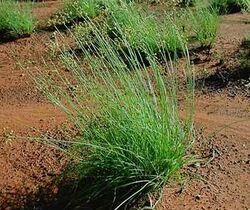Biology:Fimbristylis dichotoma
| Fimbristylis dichotoma | |
|---|---|

| |

| |
| Scientific classification | |
| Kingdom: | Plantae |
| Clade: | Tracheophytes |
| Clade: | Angiosperms |
| Clade: | Monocots |
| Clade: | Commelinids |
| Order: | Poales |
| Family: | Cyperaceae |
| Genus: | Fimbristylis |
| Species: | F. dichotoma
|
| Binomial name | |
| Fimbristylis dichotoma | |
| Synonyms | |
|
Scirpus dichotomus L. | |
Fimbristylis dichotoma, commonly known as forked fimbry[1] or eight day grass,[2] is a sedge of the family Cyperaceae that is native to tropical areas.
Description
The annual or perennial plant, 10–80 cm tall, with numerous long stems about 2 mm in diameter, slightly three-angled, compressed below the inflorescence, node-less, smooth and has a tufted habit. The root system is fibrous, wiry, black. Short rhizomes. Leaves numerous, forming a dense tuft at the base of the stem, being at least half as long as the stem.[3]
Distribution
Fimbristylis dichotoma is widely distributed in Asia, Africa and Australia[2] as well as in other parts of the tropics.[4]
Habitat
Fimbristylis dichotoma grows well on wet or even flooded soil; it is also found in uplands where the soil has good water retention. It is also found in swamps, open waste places, grassy roadsides, Imperata cylindrica grasslands and some plantation crops.[4]
References
- ↑ "Fimbristylis dichotoma". Natural Resources Conservation Service PLANTS Database. USDA. https://plants.usda.gov/core/profile?symbol=FIDI. Retrieved 28 March 2016.
- ↑ 2.0 2.1 "Fimbristylis dichotoma". FloraBase. Western Australian Government Department of Parks and Wildlife. https://florabase.dpaw.wa.gov.au/browse/profile/851.
- ↑ "tall fringe rush (Fimbristylis dichotoma)". http://www.plantwise.org/KnowledgeBank/Datasheet.aspx?dsid=20680.
- ↑ 4.0 4.1 "Fimbristylis dichotoma (tall fringe rush)". http://www.cabi.org/isc/datasheet/20680.
External links
Wikidata ☰ Q10871438 entry
 |

